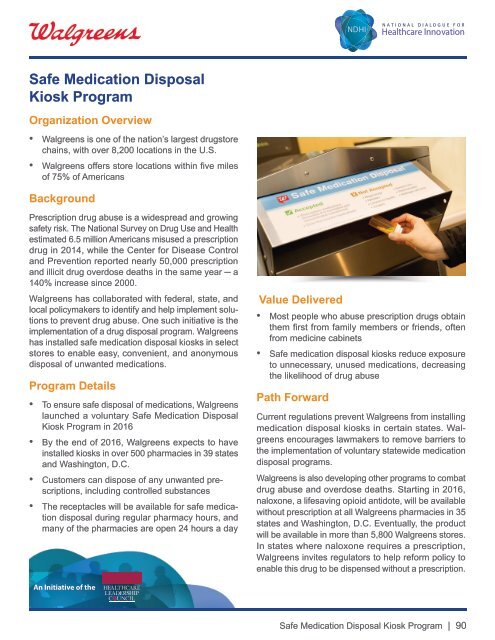VIable
HLCCompendium
HLCCompendium
You also want an ePaper? Increase the reach of your titles
YUMPU automatically turns print PDFs into web optimized ePapers that Google loves.
NDHI<br />
NAT IONAL DIALOGUE FOR<br />
Healthcare Innovation<br />
Safe Medication Disposal<br />
Kiosk Program<br />
Organization Overview<br />
• Walgreens is one of the nation’s largest drugstore<br />
chains, with over 8,200 locations in the U.S.<br />
• Walgreens offers store locations within five miles<br />
of 75% of Americans<br />
Background<br />
Prescription drug abuse is a widespread and growing<br />
safety risk. The National Survey on Drug Use and Health<br />
estimated 6.5 million Americans misused a prescription<br />
drug in 2014, while the Center for Disease Control<br />
and Prevention reported nearly 50,000 prescription<br />
and illicit drug overdose deaths in the same year ─ a<br />
140% increase since 2000.<br />
Walgreens has collaborated with federal, state, and<br />
local policymakers to identify and help implement solutions<br />
to prevent drug abuse. One such initiative is the<br />
implementation of a drug disposal program. Walgreens<br />
has installed safe medication disposal kiosks in select<br />
stores to enable easy, convenient, and anonymous<br />
disposal of unwanted medications.<br />
Program Details<br />
• To ensure safe disposal of medications, Walgreens<br />
launched a voluntary Safe Medication Disposal<br />
Kiosk Program in 2016<br />
• By the end of 2016, Walgreens expects to have<br />
installed kiosks in over 500 pharmacies in 39 states<br />
and Washington, D.C.<br />
• Customers can dispose of any unwanted prescriptions,<br />
including controlled substances<br />
• The receptacles will be available for safe medication<br />
disposal during regular pharmacy hours, and<br />
many of the pharmacies are open 24 hours a day<br />
Value Delivered<br />
• Most people who abuse prescription drugs obtain<br />
them first from family members or friends, often<br />
from medicine cabinets<br />
• Safe medication disposal kiosks reduce exposure<br />
to unnecessary, unused medications, decreasing<br />
the likelihood of drug abuse<br />
Path Forward<br />
Current regulations prevent Walgreens from installing<br />
medication disposal kiosks in certain states. Walgreens<br />
encourages lawmakers to remove barriers to<br />
the implementation of voluntary statewide medication<br />
disposal programs.<br />
Walgreens is also developing other programs to combat<br />
drug abuse and overdose deaths. Starting in 2016,<br />
naloxone, a lifesaving opioid antidote, will be available<br />
without prescription at all Walgreens pharmacies in 35<br />
states and Washington, D.C. Eventually, the product<br />
will be available in more than 5,800 Walgreens stores.<br />
In states where naloxone requires a prescription,<br />
Walgreens invites regulators to help reform policy to<br />
enable this drug to be dispensed without a prescription.<br />
Safe Medication Disposal Kiosk Program | 90


